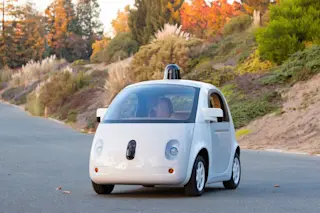Google's self-driving car prototype has a mild face for a reason. Credit: Google Robots probably won't look human when they first begin appearing on the streets in the next several years. But some robot cars such as Google's self-driving vehicles will have recognizable faces designed to win human hearts and minds. Google hopes to begin testing its custom-made robot cars on the roads of Northern California starting in 2015. Google's self-driving car prototype represents a cuddly vision of the robot future that is almost the complete opposite of what most dystopian science fiction films have imagined. The vehicle's headlights combine with a pert "nose" to give the impression of a wide-eyed baby confronting the world for the first time. Wired has described the car as "an egg with the face of a koala." Cartoonist Matthew Inman, creator of the popular website The Oatmeal, dubbed the Google cars "adorable Skynet Marshmallow ...
Google's Car Is the Face of Future Robots
Google's self-driving car prototype features a friendly face to foster trust and acceptance among human drivers.
More on Discover
Stay Curious
SubscribeTo The Magazine
Save up to 40% off the cover price when you subscribe to Discover magazine.
Subscribe













